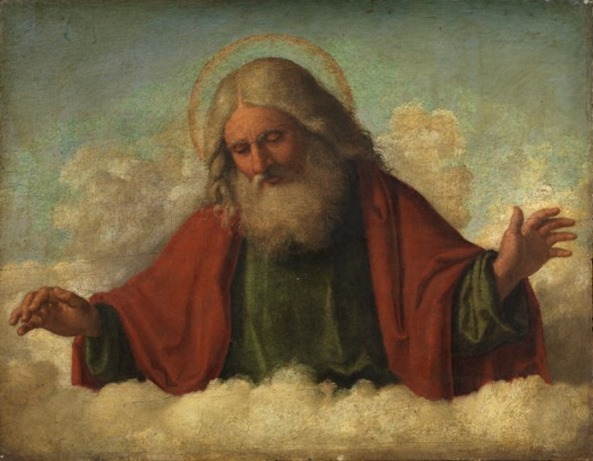God the Father by Cima da Conegliano, c. 1515
I like to think that Grow Mercy brings you the universally important scuttlebutt. So it’s probably worth mentioning that this past Monday, two Austrian mathematicians (Paleo and Benzmüller), using a method we all trust (the MacBook), proved the existence of God.
Thankfully then, to the relief of rationalists and to those with big-L logic salting their marrow, the old story about scientists climbing the mountain of Truth and coming to the top only to find there, a few lounging theologians, is a lark. It’s scientists all the way, up and down. Not sure where this leaves the atheists who’ve all along counted on Science.
Anyway, it was just a matter of time, and putting strings of numbers into a notebook. Or as P and B put it: “Formalization, Mechanization and Automation of Gödel’s Proof of God’s Existence,” in this case, “the ontological proof has been analysed for the first-time with an unprecedented degree of detail and formality with the help of higher-order theorem provers.”
The ontological argument goes back to Anselm. In a nutshell (actually there is no nutshell here), it is this: That we can have a concept of God…implies God’s necessary existence. To expand slightly, God is that than which nothing greater can be conceived. And if this being can exist in the mind, it must also exist in reality.
Or, (you can skim this) just digging out an old paper I wrote too many years ago, one I’m not sure I understand any longer: A perfect being is not impossible: Necessary existence is a perfection, hence, a perfect being exists. This form of the ontological argument claims validity through model reasoning of possible worlds. If a perfect being is possible (necessary existence being a perfection) then in some possible world a perfect being necessarily exists; and if a perfect being exists in some possible world it exists in all possible worlds and hence in which ever world is actual.
Of the big three “proofs,” of God’s existence, the cosmological (argument from design) and the teleological (argument from purpose) are more graspable. It’s the ontological one, that is, literally, the heady one.
I used to sit spellbound, watching my old philosophy professor dismantle everyone of these proofs, and then, for those of us who were left dizzy and unsure of the very desks we sat in, he would, his hands hammering the air, put them back together. Until next class’ evisceration.
The mathematicians say that their proof of Gödel’s axioms has more to do with demonstrating how superior technology can help bring about new achievements in science. But they were clever to bring God into it, because proving Gödel’s first incompleteness theorem would hardly have made the ABC news, and certainly not the Christian Post.
The question is, does it matter? To the mathematicians, there was jubilance, and why not. “It’s totally amazing that from this argument led by Gödel, all this stuff can be proven automatically in a few seconds or even less on a standard notebook.” We’re inching closer to artificial intelligence.
I don’t think, however, that all this will change your routine tomorrow. And I don’t think—to swing this whole thing in another direction—it will matter to Joseph, a young man I’ll tell you more about, but who I spoke to a few days ago, who lives on the street and is wondering about the coming winter.
A more apt question for today, (still, in my view not an unrelated question), is: Does love exist? And where? And how? In concept, or reality?


Neil deGrasse Tyson on scientists and religion. Not so much of a conflict as people seem to think.
“40% of scientists in America are religious, as in they pray to a personal God.”
http://www.youtube.com/watch?v=JbvDYyoAv9k
I like that. Thanks for this Teryl.
The atheists are in the religion departments in the universities – which I can understand. Reading stuff like this makes atheism appealing.
Agreed Sam.